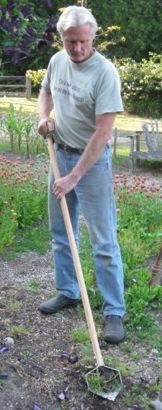Gardening
Liz Savage, Guest Blogger A dense fog shrouds the church spires across the street, and I’m bundled up in a blanket and warm socks as I write. In San Francisco, where I live, you wouldn’t know it was summer. My poor plants are certainly confused. But in the rest of the country, you and your flora are enjoying prime gardening season—and a prime time for back pain.
Avid horticulturalists know the psychological and health benefits of gardening—from moderate exercise to stress relief. Just being outside and getting your hands a little dirty can lift you out of a bad mood. And there’s nothing wrong with lifting light to moderate weights – don’t worry about that one-gallon shrub you picked up at Home Depot. But lifting a 15-gallon potted tree, or three hours spent pulling deeply rooted weeds and hoisting bags of topsoil, after a winter of inactivity, can leave a back pain sufferer ready to throw in the trowel. Before you let the weeds take over, consider a few simple changes to your gardening routine.
Many folks with bad backs practice what is called adaptive gardening. Simply put, this means modifying your garden or tools so you can continue to comfortably tend to your flowers and crops.
Fortunately, there are many tools out there for people with back pain. Long-handled tools, like the Shrew, allow you to stand up straight while weeding or hoeing. (The Shrew comes in three lengths so you can get a custom fit.) Or you can modify the tools you already have with handle extenders. Pruners or loppers with a ratchet system, as well as sharp tool blades, will also lessen the strain on your back.
You can also choose back-friendly plants for your garden. Slow-growing shrubs or ornamental grasses require less maintenance, while vines, berries, roses and container gardens minimize bending. (Watch how Cathryn harvests her blackberries.) Also consider dwarf fruit trees instead of the traditional variety. The fruit will be at an easier height for picking.
Watch Cathryn harvest her blackberries while minimizing bending.
Raised beds are essential for back pain sufferers who want to grow crops. You can build your own, like Cathryn did, to custom-fit the space available, but if you’d rather not, there are many kinds from which to choose. Because they are higher off the ground, you won’t need to bend over as much to tend to your plants.
Check out this great tutorial on building your own raised beds.
When working at a raised bed, use a kneeler with side supports that make it easier to raise and lower yourself to the ground using your arms to support your body weight rather than your back. The kneeler also flips over to be used a bench when you need a break. Make sure to position yourself directly in front of the area you are working on—avoid twisting to reach your plants.
Save yourself some weeding work by use mulch to prevent weeds. If they can’t grow, you won’t have to pull them. Of course, some weeds are inevitable. Many back pain sufferers swear by the long-handled Circlehoe. It makes fast work of weeding chores, and there’s no kneeling required.
Finally, don’t forget your back basics.
- Keep your back straight. Prolonged flexion – the curled-shrimp position – is hard on the discs, so position yourself so that you can hinge at your hips instead.
- Take breaks as needed. Don’t stay in the same position for extended periods—after 15 minutes of weeding, spend some time pruning your shrubs or harvesting some tomatoes.
- Use proper lifting techniques. The classic “lift with your knees, not with your back,” is not necessarily good advice; there are times when placing your feet on either side of the item to be lifted, and then lifting from a squat is the only way to go. Do not attempt to move a fully-loaded planter by yourself! And please, no heavy watering cans. Either install an irrigation system, or use a hose on a reel.
- Speaking of lifting, a two-wheeled cart keeps the weight of a heavy load more balanced than a standard wheelbarrow.
- Warm up before you begin working with a 10-minute walk around your garden—take time to admire your previous work and plan your tasks for the day. Stretch after you’re done.
Enjoy your long summer days in the garden. I hope the fruits of your labor are sweet strawberries—not an aching back.



